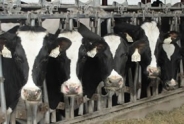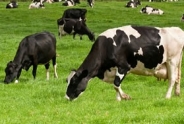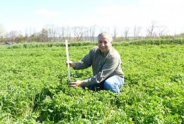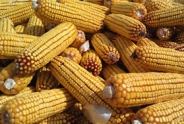Organic
 New York Organic Dairy Initiative: Adding diversity to NY's Dairy Industry
New York Organic Dairy Initiative: Adding diversity to NY's Dairy IndustryORGANIC CATEGORIES
Application To Participate in Organic Dairy Replacement Study
A. Fay Benson, Small Dairy Extension Educator
South Central New York Dairy & Field Crops
We are taking applications to participate in Organic Dairy Replacement Study. The goal of the project will be to review the treatments, techniques, and costs associated with raising heifers on these farms. We will then share averages and treatments with other organic dairies in the Northeast. The information will also help with establishing the unfair advantage allowed by the USDA by not enforcing the intent of the "Origin of Livestock" rule described in the NOP.
Milking time at family dairy farms
A. Fay Benson, Small Dairy Extension Educator
South Central New York Dairy & Field Crops
Watch these videos below for a peek inside the milking routine at local family dairy farms.
Custom Machinery Rates
Nancy Glazier, Small Farms & Livestock Specialist
Northwest New York Dairy, Livestock & Field Crops
Trying to figure out how much to pay or charge for custom machinery operations? Check out the 2016 custom rate summaries from Pennsylvania.
NYSERDA Agriculture Energy Audit Program - Fact Sheet
Janice Degni, Team Leader, Field Crop Specialist
South Central New York Dairy & Field Crops
NYSERDA offers energy audits to help eligible farms and on-farm producers identify ways to save energy and money on utility bills. Reports include recommendations for energy efficiency measures.
Two Paths to Organic Transition
A. Fay Benson, Small Dairy Extension Educator
South Central New York Dairy & Field Crops
Map of New York Organic Dairy Farms
A. Fay Benson, Small Dairy Extension Educator
South Central New York Dairy & Field Crops
There are over 400 organic dairy farms in the state, representing about 6% of the total number of dairy farms across New York. The requirements for being certified organic are suited to smaller dairies, so the average organic dairy in NY has less than 50 cows, and market demand for their milk is on the rise.
Webinar Series On Organic Weed Management
Janice Degni, Team Leader, Field Crop Specialist
South Central New York Dairy & Field Crops
Organic farmers and specialists from across the U.S. led a free webinar series on organic weed management. The webinars discuss several approaches and practices for managing weeds including crop rotations, cover crops, and soil management. Each session was recorded. They can be viewed here.
Variable Rate Fertility Management
Bill Verbeten, Field Crops
Northwest New York Dairy, Livestock & Field Crops

An expanded version of the February 2014 Ag Focus Article, Variable Rate Fertility Management.
Cover Crop InterSeeder
Bill Verbeten, Field Crops
Northwest New York Dairy, Livestock & Field Crops

Want to plant a cover crop into standing corn or soybeans, apply a herbicide, and sidedress nitrogen all in one pass? Check out the cover crop InterSeeder developed at Penn State in this PDF. For additional information go to InterSeeder website.
PEDv: What does it mean for NY's Swine Producers?
Nancy Glazier, Small Farms & Livestock Specialist
Northwest New York Dairy, Livestock & Field Crops

Porcine Epidemic Diarrhea virus (PEDv) has arrived in New York with a vengeance.
Soil Sampling for Field Crops
Bill Verbeten, Field Crops
Northwest New York Dairy, Livestock & Field Crops

Not sure how to sample your soil? Download this Cornell Agronomy Fact Sheet. More Agronomy Fact Sheets are available at the Cornell Nutrient Management Spear Program website.
Alfalfa Management Guide
Bill Verbeten, Field Crops
Northwest New York Dairy, Livestock & Field Crops

Have a question about growing alfalfa? You will probably find the answer in "The Alfalfa Management Guide". This is a must have reference for anyone working with "the queen of forages".
Upcoming Events
Winter Bale Grazing Pasture Walk
January 10, 2026
Truxton, NY
Join us for the second Bale Grazing Winter Pasture Walk!
Have you heard about or seen bale grazing and wondered if it would work for you?
Do you want to learn the nuances and logistical context for implementing this regenerative practice?
Are you interested in seeing the impacts of bale grazing on land and animals from a practicing farmer?
If you answered Yes to any question, The Northeast Region National Grazing Lands Coalition, the Cornell Cooperative Extension Hillside Farms are teaming up to showcase our Second Bale Grazing Winter Pasture Walk!
Boots in the Barn: Webinar Series
January 13, 2026
Boots in the Barn: Cornell Dairy Research Updates
Webinar Series every Tuesday starting January 13th @ 12:00pm to February 24th.
2026 Winter Crop Meeting - Auburn
January 22, 2026
Auburn, NY
Connect with the agricultural community and many key note speakers on the folllowing topics:
- Emerging Innovation in Plant Breeding and Technologies - A Peek at the Future by Ben Rogers, Pioneer Field Agronomist
- Managing Herbicide-Resistant Weeds in NY Corn & Soybean by Dr. Vipam Kumar, NYS Extension Weed Scientist, Cornell University
- Livestock Risk Protection (LRP) Insurance Program by KC Slade, Risk Management Specialist, Farm Credit East—Crop Growers
- Birds & the Bees Legislation and the Fate of Neonics by Janice Degni, Extension Field Crop Specialist
- Emerging Disease Pests and Soil Borne Diseases of Soybean by Dr. Camilo Parada Rojas, NYS Extension Plant Pathologist, Cornell University
- Solar Farms—Benefit or Detriment? by Mr. Michael McMahon, Chair, Homer Town Planning Board
4 DEC credits in categories 1A and 21-25. 1.5 PM, .5 CM and 1 PD CCA credits available.
Please send your DEC license number in the Notes to Us when you register on-line.
Announcements
Farm Participants Needed for Bale Grazing Grant!
Information on the Project:- Approximately 10 acres total needed to bale graze two different bale densities
- "Core" farms will graze two winters, "Demo" farms will graze one winter.
- Payments for both "Core" farms and "Demo" farms
- Baseline soil sampling by bale grazing team
- Forage measurements in early season by bale grazing team
- Late season clipping if residual not trampled down by farm
Cornell Cow Convos - New Podcast
On-going podcast, New episodes released on the last Thursday of the month.Guest speakers, CCE Dairy Specialists.
Housed on Soundcloud Channel is CCE Dairy Educators
- Preventative healthcare for cows
- The trend of beef on dairy
- What to look forward to in the new year for dairy
- Socially grouping or pair-housing calves
2018 Drug Residue Prevention Manual
For more than 30 years, the U.S. dairy industry has focused educational efforts on the judicious use of antibiotics through the annual publication of a Best Practices Manual. The 2018 edition of the National Dairy FARM Program: Farmers Assuring Responsible Management? Milk and Dairy Beef Drug Residue Prevention Manual is the primary educational tool for dairy farm managers throughout the country on the judicious and responsible use of antibiotics, including avoidance of drug residues in milk and meat.The manual is a quick resource to review those antibiotics approved for dairy animals and can also be used as an educational tool and resource for farm managers as they develop on-farm best management practices necessary to avoid milk and meat residues. Visit the Manual and Form Library to download copies of this important tool!
Follow us on Facebook
The team updates our facebook page frequently - follow us to be updated on our events, see some fun videos and get local area updates!facebook.com/SCNYDairyandFieldCropsTeam
NYSERDA Agriculture Energy Audit Program
NYSERDA offers energy audits to help eligible farms and on-farm producers identify ways to save energy and money on utility bills. Reports include recommendations for energy efficiency measures.For more information and the NYSERDA Agriculture Energy Audit Program Application click here






